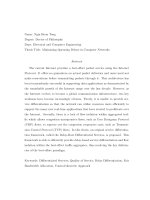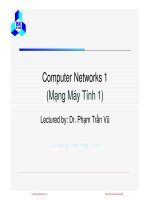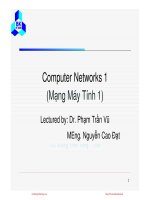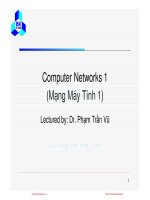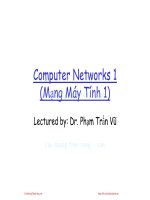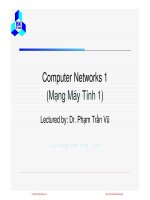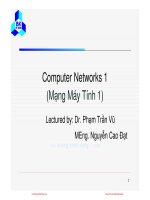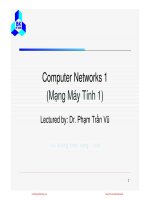Lecture Computer networks 1: Lecture 5 - Phạm Trần Vũ
Bạn đang xem bản rút gọn của tài liệu. Xem và tải ngay bản đầy đủ của tài liệu tại đây (2.34 MB, 32 trang )
Computer Networks 1
(Mạng Máy Tính 1)
Lectured by: Dr. Phạm Trần Vũ
CuuDuongThanCong.com
/>
Lecture 5: Network Layer
Reference:
Chapter 5 - “Computer Networks”,
Andrew S. Tanenbaum, 4th Edition, Prentice Hall, 2003.
CuuDuongThanCong.com
/>
Contents
The network layer design issues
Routing algorithms
Congestion control algorithms
Quality of services
Internetworking
The network layer in the Internet
3
CuuDuongThanCong.com
/>
Network Layer Design Issues
Store-and-Forward Packet Switching
Services Provided to the Transport Layer
Implementation of Connectionless Service
Implementation of Connection-Oriented Service
Comparison of Virtual-Circuit and Datagram
Subnets
4
CuuDuongThanCong.com
/>
Store-and-Forward Packet
Switching – Router
The environment of the network layer protocols.
5
CuuDuongThanCong.com
/>
Services Provided to the Transport
Layer
Network layer provides services to the
transport layer
Goals of network layer services
Independent of router technology
The transport layer should be shielded from the
number, type and topology of routers
Network addresses available to the transport
layer should be uniformed and even across
LANs and WANs
CuuDuongThanCong.com
/>
6
Two Classes of Services in the
Network Layer
Connection less service
Packets are called datagrams
The subnet is called a datagram subnet
Packets may arrive at the destination by multiple paths
Connection oriented service
The connection is called Virtual Circuit
The subnet is called a virtual circuit subnet
All packets arrive at the destination by the same route
7
CuuDuongThanCong.com
/>
Implementation of Connectionless
Service
Routing within a diagram subnet.
8
CuuDuongThanCong.com
/>
Implementation of ConnectionOriented Service
Routing within a virtual-circuit subnet.
9
CuuDuongThanCong.com
/>
Comparison of Virtual-Circuit and
Datagram Subnets
10
CuuDuongThanCong.com
/>
Routing Algorithms
To route packets from a source to a
destination
Distinction between routing and forwarding
Routing: make decision on which route to use
Forwarding: use routing tables to send packets
Two class of algorithms
Nonadaptive (static)
Adaptive
11
CuuDuongThanCong.com
/>
Fairness vs Optimality
Conflict between fairness and optimality.
12
CuuDuongThanCong.com
/>
The Optimality Principle
If router J is on the optimal path from router I
to router K, then the optimal path from J to K
is also on the same route.
(a) A subnet. (b) A sink tree for router B.
13
CuuDuongThanCong.com
/>
Common Routing Algorithms
The Optimality
Principle
Shortest Path Routing
Flooding
Distance Vector
Routing
Hierarchical Routing
Broadcast Routing
Multicast Routing
Routing for Mobile
Hosts
Routing in Ad Hoc
Networks
Link State Routing
14
CuuDuongThanCong.com
/>
Shortest Path Routing
Use Dijkstra algorithm
15
CuuDuongThanCong.com
/>
Flooding
Incoming packets are sent to every outgoing
lines
Generate vast numbers of duplicates
Alternatives for improvement
Tracking packets sent
Use TTL (time-to-live)
Selective flooding
Not practical in most applications
16
CuuDuongThanCong.com
/>
Distance Vector Routing (1)
Also known as Bellman-Ford and Ford-Fulkerson
algorithm
Originally was used in ARPANET
Used in Internet under RIP
Each router having a table of the best known
distance to each destination and the preferred
outgoing line to get there
Periodically, a router exchanges its table with its
neigbors
Then, all routers recalculate their tables
17
CuuDuongThanCong.com
/>
Distance Vector Routing (2)
(a) A subnet. (b) Input from A, I, H, K, and the new
routing table for J.
18
CuuDuongThanCong.com
/>
Distance Vector Routing (3)
The count-to-infinity problem
a) initially, all routers are down
b) Initially, all routers are up, then A is down
19
CuuDuongThanCong.com
/>
Link State Routing
Each router must do the following:
Discover its neighbors, learn their network
address.
Measure the delay or cost to each of its
neighbors.
Construct a packet telling all it has just learned.
Send this packet to all other routers.
Compute the shortest path to every other router.
20
CuuDuongThanCong.com
/>
Learning about the Neighbors
(a) Nine routers and a LAN. (b) A
graph model of (a).
21
CuuDuongThanCong.com
/>
Measuring Line Cost
A subnet in which the East and West parts are
connected by two lines.
22
CuuDuongThanCong.com
/>
Building Link State Packets
(a) A subnet. (b) The link state packets for
this subnet.
23
CuuDuongThanCong.com
/>
Distributing the Link State Packets
The packet buffer for router B in the previous
slide
24
CuuDuongThanCong.com
/>
Hierarchical Routing
25
CuuDuongThanCong.com
/>
